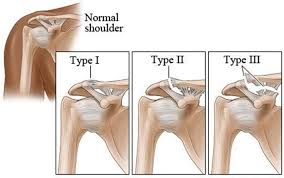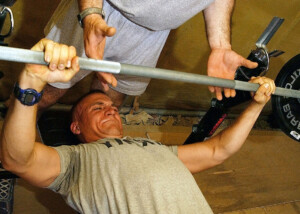Since the ligaments are torn in a grade 2 AC separation, why isn’t surgery the treatment of choice?
One day I was doing stool stepping exercise in my living room.
Suddenly, it were as though an unseen force yanked me off the stool while I had one foot on it and threw me to the floor.
It was over in a split second; too quickly for my athletic body to react. I landed on my shoulder and it hurt like hell.
I diagnosed myself with a possible AC separation, either a grade 1 or 2.
Separation of the acromioclavicular joint is usually caused by falling on one’s shoulder — which can happen after falling from a height or being tossed from a bicycle or skateboard.
A more serious injury (higher grade) may occur from a vehicular accident.
In a grade 2 AC separation, ligaments are torn from the bone.
A ligament is a type of connective tissue that connects bones to other bones at joints, providing stability and support.
Ligaments are composed primarily of dense, fibrous collagen fibers, which give them strength and flexibility.
Now in the case of an ankle injury in which ligaments are actually severed, surgery is the standard treatment. Same with the ligaments in the knee.
So I wondered why, in the case of a grade 2 AC injury, surgery isn’t performed.
“It is not recommended because it has not been shown to significantly improve the average person’s long-term function,” says Jonathan Oheb, MD, North Valley Orthopedic Institute, Chief of Orthopedic Hand and Upper Extremity Surgery.
“However, with a high demand patient who continues to have symptoms after a course of conservative treatment, surgery would then be an option.”
In my case, the injury turned out to be a hairline fracture of the clavicle.
This type of fracture is typically caused by trauma or impact, such as a fall or direct blow to the shoulder.
The symptoms were identical to that of a grade 1 or 2 AC joint trauma save for a visible deformity.
Treatment for a hairline clavicle fracture often focuses on pain management and immobilization of the shoulder, commonly with a sling or brace.
My injury healed beautifully with patience plus a homemade sling.
Standard Treatment for a Grade 2 AC Joint Injury
- Rest from activity
- Use of a sling
- Cold packs
- Painkillers
- Physical therapy
The above protocol works superbly; surgery is not required unless the injury is really severe.
Prevention of an AC joint separation is not related to physical fitness.
It’s related to activity. Be extra careful when you’re involved in activity that has the potential to cause a fall.
This includes hiking downhill and walking down an outdoor staircase that’s coated with a thin, often not very visible, layer of ice.


 In addition to hand, elbow and shoulder care, Dr. Oheb provides comprehensive surgical and nonsurgical treatment for all orthopedic conditions of the hip, knee and ankle, including broken bones and injuries.
In addition to hand, elbow and shoulder care, Dr. Oheb provides comprehensive surgical and nonsurgical treatment for all orthopedic conditions of the hip, knee and ankle, including broken bones and injuries. 
























